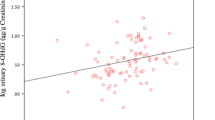Summary
This article reports results regarding two different physiological aspects of 2,5-hexanedione (2,5-HD). The first is the relationship between “free” 2,5-HD (the fraction of “real” 2,5-HD) and “total” 2,5-HD (2,5-HD obtained from acid hydrolysis) in urine and blood of workers exposed ton-hexane. The second part of the study is an attempt to clarify “physiological” excretion of 2,5-HD in subjects not occupationally exposed ton-hexane. The concentration of free 2,5-HD in urine of workers exposed ton-hexane is about 8% of total urinary 2,5-HD. In blood, free 2,5-HD is about 50% of the total. The serum concentration range of total and free 2,5-HD in workers from whom blood was taken was 33–418 μg/l and 14–283 μg/l respectively. In subjects not exposed ton-hexane, urinary concentration of 2,5-HD ranged between 0.17 and 0.98 mg/1, the urinary excretion rate between 0.23 and 0.57μg/min, and renal clearance between 14 and 66 ml/min. The blood concentration of 2,5-HD in nonexposed subjects was 6–30μg/1. Fluctuations typical of a circadian rhythm were not observed for 2,5-HD in blood or urine. We think that 2,5-HD is mainly a product of intermediate metabolism in the human body. Only a minimal part could derive fromn-hexane as a ubiquitous micropollutant.
Similar content being viewed by others
References
Ahonen I, Schimberg RW (1988) 2,5-hexanedione excretion after occupational exposure ton-hexane. Br J Ind Med 45:133–136
Antoine SR, De Leon IR, O'Dell-Smith RM (1986) Environmentally significant volatile organic pollutants in human blood. Bull Environ Contam Toxicol 36:364–371
Brugnone F, Perbellini L, Gaffuri E, Apostoli P (1980) Biomonitoring of industrial solvent exposures in workers' alveolar air. Int Arch Occup Environ Health 47:245–261
DeBortoli M, Knoppel H, Pecchio E, et al. (1985) Measurements of indoor air quality and comparison with ambient air: a study on 15 homes in northern Italy. Commission of the European Communities, Luxembourg
DiVincenzo GD, Kaplan CJ, Dedinas J (1976) Characterization of the metabolies of methyl-n-butyl ketone, methylisobutyl ketone, and methylethyl ketone in guinea pig serum and their clearance. Toxicol App] Pharmacol 36:511–522
Fedtke N, Bolt HM (1986) Detection of 2,5-hexanedione in the urine of persons not exposed ton-hexane. Int Arch Occup Environ Health 57:143–148
Fedtke N, Bolt HM (1986) Methodological investigations on the determination ofn-hexane metabolites in urine. Int Arch Occup Environ Health 57:149–158
Fedtke N, Bolt HM (1987) The relevance of 4,5-dihydroxy-2-hexanone in the excretion kinetics ofn-hexane metabolites in rat and man. Arch Toxicol 61:131–137
Filser JG, Bolt HM, Muliawan H, Kappus H (1983) Quantitative evaluation of ethane andn-pentane as indicator of lipid peroxidation in vivo. Arch Toxicol 52:135–147
Iwata M, Takeuchi Y, Hisanaga N, Ono Y (1983) A study on biological monitoring ofn-hexane exposure. Int Arch Occup Environ Health 51:253–260
Krotoszynski BK, Bruneau GM, O'Neill HJ (1979) Measurements of chemical inhalation exposure in an urban population in the presence of endogenous effluents. J Anal Toxicol 3:225–234
Mutti A, Falzoi M, Lucertini S, et al. (1984)n-Hexane metabolism in occupationally exposed workers. Br J Ind Med 41:533–538
Perbellini L, Brugnone F, Pavan I (1980) Identification of the metabolites ofn-hexane, cyclohexane and their isomers in men's urine. Toxicol Appl Pharmacol 53:220–229
Perbellini L, Bartolucci GB, Brugnone F, De Rosa E, Valentini F (1985) Il 2,5-esanedione nel controllo biologico dell'espozione professionale an-esano. (Biological monitoring of workers exposed ton-hexane using the 2,5-hexanedione). Med Lav 76:35–43
Perbellini L, Tagliaro F, Maschio S, Zedde A, Brugnone F (1986) Dosaggio Gas-cromatografico del 2,5-esandione. Med Lav 77:628–634
Perbellini L, Pasini F, Faccini GB, Danzi B, Gobbi M, Zedde A, Circilllo P, Brugnone F (1988) Determinazione di solvenni ad use industriale nel sangue, nella aria alveolare e nell'urina di un gruppo di donatori di sangue. Med Lav 79:460–467
Perbellini L, Marhuenda Amoros D, Cardona Llorens A, Giuliari C, Brugnone F (1990) An improved method of analysing 2,5-hexanedione in urine. Br J Ind Med 47:421–424
Spencer PS, Schaumburg HH (1975) Experimental neuropathy produced by 2,5-hexanedione, a major metabolite of the neurotoxic industrial solvent methyl-n-butyl-ketone. J Neurol Neurosurg Psychiatry 8:771–775
Walle T (1968) Quantitative gas-chromatographic determination of primary amines in submicrogram quantities after condensation with 2,5-hexanedione. Acta Pharm Suec 5:353–366
Author information
Authors and Affiliations
Rights and permissions
About this article
Cite this article
Perbellini, L., Pezzoli, G., Brugnone, F. et al. Biochemical and physiological aspects of 2,5-hexanedione: endogenous or exogenous product?. Int. Arch Occup Environ Heath 65, 49–52 (1993). https://doi.org/10.1007/BF00586058
Received:
Accepted:
Issue Date:
DOI: https://doi.org/10.1007/BF00586058




